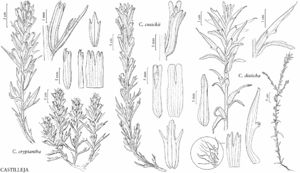Difference between revisions of "Castilleja cusickii"
Bot. Gaz. 25: 267. 1898.
FNA>Volume Importer |
FNA>Volume Importer |
||
| Line 33: | Line 33: | ||
|elevation=500–2500 m. | |elevation=500–2500 m. | ||
|distribution=Alta.;B.C.;Idaho;Mont.;Nev.;Oreg.;Wash.;Wyo. | |distribution=Alta.;B.C.;Idaho;Mont.;Nev.;Oreg.;Wash.;Wyo. | ||
| − | |discussion=<p>Castilleja cusickii includes two morphologically distinct variants. One variant has a wider inflorescence, broader bracts, and wider bract lobes. These bracts often have highly contrasting purple veins, and some populations also have a purplish wash on the bracts. These plants have a range on the western edge of typical C. cusickii, though overlapping with more typical forms in western Idaho and adjacent northeastern Oregon and southeastern Washington. The name C. lutea is available for these variants, and both consistent morphological differences and preliminary results from ongoing genetic research on the plants (D. C. Tank, pers. comm.) indicate its resurrection may be justified. A second variant is distinguished by a pale pink-purple wash on the bracts and a narrow distribution in the meadows of the Bear River Valley, bordering northwestern Utah and adjacent southeastern Idaho. Only bract coloration appears to distinguish this form from typical C. cusickii, and the distinctive bract coloration is only more or less consistent in these populations.</p><!-- | + | |discussion=<p><i>Castilleja cusickii</i> includes two morphologically distinct variants. One variant has a wider inflorescence, broader bracts, and wider bract lobes. These bracts often have highly contrasting purple veins, and some populations also have a purplish wash on the bracts. These plants have a range on the western edge of typical <i>C. cusickii</i>, though overlapping with more typical forms in western Idaho and adjacent northeastern Oregon and southeastern Washington. The name <i>C. lutea</i> is available for these variants, and both consistent morphological differences and preliminary results from ongoing genetic research on the plants (D. C. Tank, pers. comm.) indicate its resurrection may be justified. A second variant is distinguished by a pale pink-purple wash on the bracts and a narrow distribution in the meadows of the Bear River Valley, bordering northwestern Utah and adjacent southeastern Idaho. Only bract coloration appears to distinguish this form from typical <i>C. cusickii</i>, and the distinctive bract coloration is only more or less consistent in these populations.</p><!-- |
| − | --><p>Typical Castilleja cusickii appears to hybridize with C. gracillima in the Logan Valley, Grant County, Oregon. It is also reported by M. Ownbey (1959) to hybridize with C. miniata and C. rhexiifolia.</p> | + | --><p>Typical <i>Castilleja cusickii</i> appears to hybridize with <i>C. gracillima</i> in the Logan Valley, Grant County, Oregon. It is also reported by M. Ownbey (1959) to hybridize with <i>C. miniata</i> and <i>C. rhexiifolia</i>.</p> |
|tables= | |tables= | ||
|references= | |references= | ||
| Line 58: | Line 58: | ||
|publication year=1898 | |publication year=1898 | ||
|special status=Selected by author to be illustrated;Endemic | |special status=Selected by author to be illustrated;Endemic | ||
| − | |source xml=https://jpend@bitbucket.org/aafc-mbb/fna-data-curation.git/src/ | + | |source xml=https://jpend@bitbucket.org/aafc-mbb/fna-data-curation.git/src/8f726806613d60c220dc4493de13607dd3150896/coarse_grained_fna_xml/V17/V17_1053.xml |
|genus=Castilleja | |genus=Castilleja | ||
|species=Castilleja cusickii | |species=Castilleja cusickii | ||
Revision as of 14:55, 18 September 2019
Herbs, perennial, (1–)1.5–5(–6) dm; from a small, woody caudex; with a taproot or stout, branched roots. Stems solitary or few to several, erect, often decumbent at base, unbranched, sometimes branched, hairs spreading, long, soft, eglandular, mixed with shorter, sometimes stiff, stipitate-glandular ones. Leaves green, sometimes with prominent red-purple veins, lanceolate-linear to broadly lanceolate, 2.5–4.5(–7) cm, not fleshy, margins plane, flat, (0–)3–5(–9)-lobed, apex acuminate to acute; lobes spreading-ascending, narrowly lanceolate, arising at or above mid length, apex acute. Inflorescences 3.5–26 × 1.5–3.5 cm; bracts pale green, pale greenish yellow, or pale yellow throughout, or proximally pale green, pale greenish yellow, pale yellow, or reddish purple, distally white, yellow, pink, dull purple, or dull reddish purple, sometimes with a purple band below that, sometimes with veins darker than background color, lanceolate to oblong, 0–5(–9)-lobed; lobes ascending or spreading, linear to narrowly lanceolate, often short, arising above mid length, central lobe apex rounded, lateral ones acute to rounded. Calyces green, pale green, or pale yellow, lobes yellow to pale yellow, 20–30 mm; abaxial and adaxial clefts 6.6–14 mm, 33–50% of calyx length, deeper than laterals, lateral 0–4(–4.5) mm, 0–15% of calyx length; lobes broadly rounded to triangular, apex obtuse to rounded. Corollas straight, 19–25(–28) mm; tube (13–)15–20 mm; abaxial lip included, beak not or slightly exserted; beak adaxially green to yellow-green, 4–7 mm; abaxial lip yellow, prominent, inflated, 2–4.5 mm, ca. 75% as long as beak; teeth incurved to erect, white, 1.3–2.1 mm. 2n = 24.
Phenology: Flowering Apr–Aug.
Habitat: Moist meadows, swales, grasslands in sagebrush steppes, occasionally to subalpine.
Elevation: 500–2500 m.
Distribution
Alta., B.C., Idaho, Mont., Nev., Oreg., Wash., Wyo.
Discussion
Castilleja cusickii includes two morphologically distinct variants. One variant has a wider inflorescence, broader bracts, and wider bract lobes. These bracts often have highly contrasting purple veins, and some populations also have a purplish wash on the bracts. These plants have a range on the western edge of typical C. cusickii, though overlapping with more typical forms in western Idaho and adjacent northeastern Oregon and southeastern Washington. The name C. lutea is available for these variants, and both consistent morphological differences and preliminary results from ongoing genetic research on the plants (D. C. Tank, pers. comm.) indicate its resurrection may be justified. A second variant is distinguished by a pale pink-purple wash on the bracts and a narrow distribution in the meadows of the Bear River Valley, bordering northwestern Utah and adjacent southeastern Idaho. Only bract coloration appears to distinguish this form from typical C. cusickii, and the distinctive bract coloration is only more or less consistent in these populations.
Typical Castilleja cusickii appears to hybridize with C. gracillima in the Logan Valley, Grant County, Oregon. It is also reported by M. Ownbey (1959) to hybridize with C. miniata and C. rhexiifolia.
Selected References
None.
